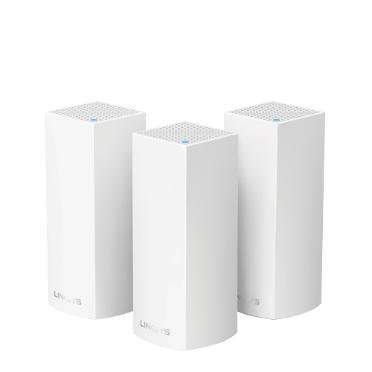Positives:
* Easy setup and management.
* Consistent speed throughout the house.
* Good coverage.
* High efficiency.
* Can be managed via web, mobile app from anywhere.
Negatives:
* High cost.
Slowness in solving problems by the company.
* Some stability issues for some users
I return to you today, after a long absence, with a review of the network device from Linksys Linksys VelopIt is a mesh network system from the international company Linksys.
This system is similar to the Google Wi-Fi system, which I wrote a review about a while ago, and there are many competing products that work with the same feature, from Telelink, Asus, and Netgear.
The system depends on the multiplicity of devices, to provide excellent coverage everywhere in the house, with the same speed and efficiency, so that the devices are distributed in multiple places in the house, then these devices communicate with each other wirelessly, to form one network.
You've got a 3-piece set that can cover up to 6,000 square feet, according to the company.
preparation:
The setup process was easy overall, the app takes you step by step to complete the network setup. I only encountered a problem, in the necessity of writing the password for the temporary Wi-Fi network created by the device, which is written below it. Google was smarter, as it does not require you more than scanning the QR code at the bottom of the device, and it will recognize it directly.
After setting up the first piece that is connected to the main modem, you can add other pieces easily, and it does not require writing anything this time.
Network management:
When you finish setting up the network, you will see the network information and the status of the devices. In the dashboard, you can see the status of each device in detail.
Using the application or the web interface, you can turn on the guest network, control parental controls, set the priority of devices to give a particular device eg high bandwidth.
Also, you can control many advanced options for the network, more than the options provided by the Google system, for example.
the performance:
Network performance is very good, the speed is consistent throughout the house, I have 20mb internet, I was getting the same speed everywhere I tested it.
From what I noticed, the Velop system provides excellent performance even if you are far from the nearest point to you, and the network's absorption of traffic is greater than Google Wi-Fi, perhaps because it is a tri-band.
Coverage is better than Google Wi-Fi in general, but you probably won't notice much difference in the case of concrete walls and barriers.
Quickly, if we want to compare it with the Google system, I can simply say that Google is programmatically superior to Linksys, perhaps because this is Google's area of expertise. While Linksys excels in hardware, network performance. Again because this is the specialty of Linksys.
Problems for some users:
I've read a lot on the Linksys support forums, what some users are writing about, about problems they're having with signal stability, as well as other performance issues. Although I have not encountered problems of this kind. But I noticed that the company was late in issuing updates, for example the update that was supposed to be released last January, the company issued it at the end of March, and it was withdrawn before that more than once.
Conclusion:
The Linksys Velop system is one of the best mesh network systems. It outperforms its competitors in performance tests and offers great coverage.
On the other hand, the price may be the biggest obstacle for users to obtain this system, especially since the competing systems at a lower price offer very good performance that suits most users.
to update.
Since I wrote this review, and until now, I have been using the Velop system at home. You added more devices. And the network works great.


Leave a Reply